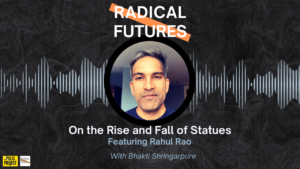

The title of Hafsa Kanjwal’s book, Colonizing Kashmir: State-Building under Indian Occupation (Stanford University Press: 2023), was renamed A Fate Written on Matchboxes: State-Building in Kashmir Under India (Navayana) for Indian readers. This change already speaks volumes about the challenges that the original title poses to the Indian claim of political supremacy over Kashmir. The choice of the term “matchboxes” in the new title is rooted in a popular anecdote about Bakshi Ghulam Muhammad, the former Prime Minister of Jammu and Kashmir from 1953 to 1964, who would offer employment to students he met on the street if they had completed standard eight at school. The appointment letter would be written on matchboxes or scraps of paper. The matchboxes thus act as a metaphor that simultaneously evokes the fragility and capriciousness of Kashmir’s fate under Indian administration.
The changed title similarly eschews the political heft of the term “colonization”. This reframing illustrates how vocabulary becomes a battleground on which truth and historiography struggle for primacy. The terminology as a site of contestation is clearly a means to censor the literature. The recent ban on A Fate Written on Matchboxes, along with 25 other books by various authors, imposed on August 5th, 2025, in Jammu and Kashmir, is an extension of the threat posed by the written documentation of history.
Despite possessing the world’s largest democratic mandate, deriving legitimacy from its Constitution, postcolonial India has denied the same mandate to Kashmir. It is not just in the political sphere that India colonizes Kashmir, according to Kanjwal; even the seminal academic scholarship of the “Subaltern Studies Collective, in particular, has played a role in a ‘sanctioned ignorance’.” By situating Kashmir not as a peripheral anomaly, but as an active constitutive site of Indian political modernity, Kanjwal challenges dominant paradigms that have long framed the region’s integration into India as either an administrative fait accompli or a security variance.
Kanjwal’s deep archival, discursive, and ethnographic exploration illuminates an alternative genealogy of occupation. A Fate Written on Matchboxes prompts a rethinking of India’s self-fashioned normalcy, which intends to integrate Kashmir both territorially and ideologically into the Indian polity. In doing so, Kanjwal foregrounds how postcolonial nation-states—notwithstanding their own histories of subjugation—simulate colonial action within their borders.
A Methodological and Historiographic Coup
Kanjwal’s decision to focus on the decade spanning 1953-1963 is a methodological and historiographic coup. Crucially, she examines the period following the ouster and arrest of Sheikh Abdullah, the pro-India Kashmiri leader, specifically under the directive of Prime Minister Jawaharlal Nehru, in August 1953. This choice foregrounds a critical interregnum in which the Indian state power had to confront the crisis of Kashmiri alienation, while simultaneously manufacturing a narrative of constitutional integration.
Kanjwal repositions the Bakshi regime—dismissed in official historiography as a transitional or collaborative government—as part of the Indian state apparatus operating in Kashmir. Bakshi’s rule, backed by New Delhi and bolstered by an extensive propaganda apparatus, including State-determined media platforms, sought to forestall plebiscitary demands through a dual strategy: pacification, by an oblique suppression of dissent vis-à-vis allegiance to the party favourites; and patronage, by offering government jobs and development funds to political loyalists. Thus, Kanjwal contests the notion that this was a ‘normal’ period in Kashmir’s political life, demonstrating instead that it was the crucible in which the seeds of contemporary Kashmiri crises, disenfranchisement, surveillance, and dependency were sown.
Kanjwal further demonstrates that the transformation of Jammu from a Muslim-majority to a Hindu-majority region was not merely a demographic shift, but a political act aimed at reconstituting the symbolic geography of the state to align with India’s secular nationalist ideology. She excavates an excised event from mainstream Indian narrative: the anti-feudal and anti-colonial resistance of Muslims, determined by agrarian grievances, against Maharaja Hari Singh’s high-handedness in Poonch, Mirpur, and Jammu during August-October 1947. This resistance movement was followed by the Jammu massacre of 1947, perpetrated by Rashtriya Swayamsevak Sangh (RSS) militias and the armed forces of the princely state of Patiala, in which tens of thousands of Muslims were killed and forcibly displaced. The dominant nationalist discourse underscores only the ‘Kashmir Valley’s resistance’ against the incursion of Pakistani tribal forces as the pivotal reason for the Indian military entering Kashmir to fight foreign invasion. This hierarchy of events thus vindicates India’s democratic accession of Kashmir, framing it in response and opposition to Pakistani Muslim nationalism.
The deliberate obfuscation and reframing of the Jammu massacre, and the accompanying demographic reengineering, have enabled the construction of an identity for Kashmir that is congruent with the Indian state’s “secular politics of inclusion.” Multiple cycles of violence, dispossession, and dislocation have created a new Kashmiri identity that is compatible with the Indian state. The culmination of this deliberate and methodical state-enacted trajectory is the revocation of Articles 370 and 35A of the Indian Constitution in August 2019 by the Bharatiya Janata Party (BJP). These constitutional provisions had historically conferred a degree of autonomy upon Jammu and Kashmir. Their abrogation marks not only a juridical reconfiguration of the region’s relationship with the Indian Union, but also the consolidation of a settler-colonial project that seeks to inscribe a new political, cultural, and demographic order upon the territory.
Kanjwal argues that Indian rule in Kashmir could never be legitimized solely through democratic means, given the fundamental rift between the Kashmiri populace’s aspirations for self-determination and India’s insistence on territorial sovereignty. One of the theoretical interventions made in A Fate Written on Matchboxes is the Indian government’s intention that, with “improved standard of living and greater prosperity, Kashmiri—especially Kashmiri Muslim—sentiments would shift in favour of India, toward a form of emotional integration.”
Media and Propaganda as Tools of Occupation
One of the book’s most compelling contributions lies in its analysis of media and propaganda as tools of “epistemic occupation.” Kanjwal clarifies that the Indian and the Bakshi governments collaborated to fabricate a narrative of “normalcy” in Kashmir that meticulously catered to the desires of both domestic and international audiences. In the shadow of Cold War politics, Bakshi presented Kashmir as a laboratory of experiments on anti-colonial and democratic rules and regulations, of which he was the prime mover. Tours to this ‘paradise on earth’, sold and celebrated to the foreign press and bureaucrats, were an integral part of creating a façade of normalcy.
In the face of the Partition of Palestine in 1947-8, Kanjwal explains, Bakshi (mis)constructed a labyrinth of solidarities for the Arab world to observe the ‘normalcy’ of the otherwise politically fraught position of Kashmiri Muslims. Between 1954 and 1956, the Department of Information invited foreign delegates from Afghanistan, Iraq, Turkey, Egypt, and Indonesia. This was a spectacle aimed at reorienting the international perception by building an appearance of global accord on the issue of Jammu and Kashmir. Bakshi, complicit with Nehru’s government, employed a discourse rooted in anti-colonialism and Third World solidarity to counterbalance the emerging U.S.-Pakistan alliance.
But this merely perpetuated the status quo, characterized by injustice and intolerance faced by Kashmiri Muslims. The orchestration opened a space to perpetuate the political status quo in Kashmir, with the added effect of turning demands for a plebiscite moot. The visit of Nikolai Bulganin and Nikita Khrushchev to Kashmir consolidated India’s occupation of Kashmir. “The Russians are the first great power to have accepted the accession of Kashmir to India as final,” mentions Karan Singh in a letter to Nehru.
When Nehru anthropomorphizes Kashmir as an “enchantress,” Kanjwal argues, he echoes the colonial objectification of “land to be exploited”. The territorial control of Kashmir saw an organised production of dependency, docility, and entertainment bound to a network of economic planning, education, and cultural policy. The economic policies manifested as fiscal integration, budgetary subordination, and developmental patronage. The tag of ‘development’ rendered occupation invisible, its violence displaced by discourses of modernization and uplift. Though posited as a deviation from the logic of colonial rule, it was, in fact, a perpetuation of the same: an avoidance of the political possibility of self-determination through economic dependency.
Kanjwal emphasizes how, to dissolve the binary between coercion and consent, the Indian state sought to fabricate legitimacy in Kashmir not through electoral manipulation or security repression, but through an expansive project of “coloniality of development”. What Kanjwal calls “emotional integration” is an attempt to create a semblance of assimilation, which attempts to eliminate the distinct historical and political context of Kashmir. This acquaints readers with the decolonial hermeneutics that are antithetical to the populist nationalist teleology.
The Extractivist Monopoly of the Indian State
The extractivist monopoly of the Indian government is replicated in the geographies of North Eastern India, including Arunachal Pradesh, Assam, Manipur, Meghalaya, Mizoram, Nagaland, and Tripura, where a similar mineral rush underwrites military rule. Dolly Kikon’s research expands on the exploitative economic development in Nagaland as a justification for prolonged military presence under the Armed Forces (Special Powers) Act (AFSPA), imposed and implemented in both the regions of Jammu and Kashmir and Ladakh, and the North East in 1958. Kikon and Kanjwal thus expose state plans to domesticate colonial logic within the postcolonial statecraft. Under the panoptics of settler-colonial regimes, the coloniality of development perpetuates across the globe: Palestine, Papua New Guinea, and parts of West Papua to laboriously capitalise on the land resources with the tools of sovereign occupation under the garb of ease, everyday survival.
The construction of the Banihal Tunnel, over a decade (2011-2021), established a tangible connection between India and Kashmir, transforming the symbolic accession into a territorial reality. Sarvepalli Radhakrishnan, the then vice prime minister of India, remarked at its inauguration that the tunnel was a “permanent and lasting physical link between the Kashmir Valley and the rest of the country.” Despite this integrationist vision, Kashmir remained financially dependent on the Indian state. Only 31 percent of its total revenue came from internal taxation, far below the national average of 66 percent among Indian states. A disproportionately large budget was allocated to the Departments of Information, Police, and Intelligence, as opposed to Indian states. Within an integration framework, the government’s primary focus, driven by political imperatives, was on the developmental narrative rather than sustainable economic advancement.
The State’s reconfiguration of academic curricula and pedagogical practices is in close proximity to economic dependency. “The purpose of a progressive educational policy was primarily to meet the economic goals of the state,” Kanjwal writes, highlighting that when the focus of educational institutes settled on the teaching of Urdu as opposed to Kashmiri, it alienated the populace from one of its primary identity-markers: mother tongue. Feeding economic dependency into linguistic erasure in an effort to cast a shadow over the creative minds of Kashmir does not stand alone. The poor financial condition of the cultural intelligentsia prompted the Bakshi government to promise them administrative jobs—a way to channelize their creativity into the sphere of commodities. This barter slipped into a compromised view on the cultural violence meted out under the settler-colonial arrangement.
Nonetheless, figures like Akhtar Mohiuddin, who renounced his Padma Shri in 1990, a sign of protest against the mass killings during the armed movement against Indian rule, reaffirm the integrity and loyalty of local voices. The Bakshi government’s cultural policy, as both spectacle and strategy for the illusion of harmonious integration, obliterated the political content of Kashmiri cultural expressions. As Kanjwal suggests, financial burden curtails political autonomy and facilitates the ideological work of education, while the educational system undergirds a sanitized cultural imagination: a conformist with the state’s integrative aspirations. The Indian state’s presence in Kashmir emerges not merely as territorial occupation, but as a mode of governance sustained through the insidious circuit of ordinary practices, promoting an essentialist amnesia that obliterates the memory of political subjugation to maintain the status quo.
The pervasive shadow of surveillance in Kashmir is a persistent intimation of suspicion and mistrust. Kanjwal elucidates that the constant apparition, when conjoined with the display of military aggression, conjures a milieu of socio-political precarity. Akin to the fate of matchboxes, the innocuous objects with the promise of fire, the militarized landscape of Kashmir, populated by checkpoints, unmarked vehicles, and armed personnel, elicits a state of apprehension, where the potential for violence simmers beneath the veneer of normalcy.
Tracing the Origins of the 1989 Armed Insurgency
Towards this end, A Fate Written on Matchboxes also focuses on how the brewing distrust of the political motives of Bakshi, as well as the Abdullah government, under the umbrella of Indian administration, metamorphosed into the armed insurgency of 1989. Kanjwal underscores that the Public Safety Act (PSA) of 1978 delegitimized the vision of the Plebiscite Front for an alternative future. The censorship of pro-plebiscite literature as well as the arrest of Mirza Afzal Beg, for instance, encapsulate what Aníbal Quijano terms “coloniality of knowledge,” where the right to self-determination is vilified as an exclusionary demand.
The bureaucratic vocabulary of ‘public order’, ‘anti-national activities’, and ‘foreign infiltration’ at once denied the repressive Indian occupation, justifying it as a colonial act of reformation to combat the “ugly situation”. This is perpetuated in the current times with frequent arrests of journalists under the Unlawful Activities (Prevention) Amendment Act (UAPA), which permits detention without charge for up to one hundred eighty days. The 2020 Media Policy authorized the Directorate of the state-run Department of Information and Public Relations (DIPR), Kashmir, to label the content of print, electronic, and other forms of media in Kashmir as fake, plagiarized, and unethical.
The Indian State’s paradoxical professing of decolonial correctness while performing colonial subjugation highlights the urgency to check the limits of decolonization as a production of knowledge. This inconsistency reshaped into ambivalence, which both the National Conference and Muslim Conference, led by Abdullah and Bakshi respectively, instrumentalized public disillusionment around the possibility of self-determination. The alienation experienced by Kashmiris was not the response of a passive victim. The act of resistance, Kanjwal contends, “mobilized the entire generation of Kashmiris that became politically invested in the right of self-determination” to sustain the struggle for azadi (freedom).
The leftist intellectuals under the helm of Sheikh Abdullah authored the Naya Kashmir manifesto, persistently evoked in A Fate Written on Matchboxes, which articulates a vision of a progressive, secular, and egalitarian society. The manifesto bore the clear imprint of socialist and Marxist ideals, seeking to reimagine Kashmir as a space of democratic participation and socio-economic justice for the Bakshi regime as well. However, the trajectory of Kashmiri politics did not ultimately follow this ideological blueprint.
One is forced to speculate: had historical occurrences played out differently—Sheikh Abdulla not been conspicuously arrested—might Kashmir have leaned towards a leftist political order? While speculative, this underscores the contested and contingent nature of political imaginaries in the region. The title Naya Kashmir (New Kashmir) inevitably reverberates with the rhetoric of Naya Bharat (New India), promoted by the current BJP-led government, aiming for economic growth and national unity. The play of words is a parody of Naya Kashmir—relegated to the forgotten vision in the face of regressive Kashmir—languishing as a conflict-torn zone in a constant need of rescue by Naya Bharat.
A Sustained Colonial Project
A Fate Written on Matchboxes, when situated in the recent two decades of the growing academic scholarship on Kashmir, anchored by Mona Bhan, Mridu Rai and Ather Zia, unpacks the interests of a sustained colonial project, rather than dismissing the disturbed situation under the canopy of a conflict zone. In doing so, Kanjwal draws upon Mahmood Mamdani’s work to map colonialism as not merely visual or textual representations, but also infrastructural and performative in practice. The state-controlled media manufactures consent to resonate with Gramscian notions of hegemony, where truth is contrived and not coveted. Kanjwal convincingly demonstrates that normalization is not the absence of conflict, but its strategic mystification.
Kanjwal prompts the readers to think beyond the liberal democratic metric of electoral (mal) practice, namely that representative politics is punctuated by historical betrayal and military aggression. In this regard, her analysis echoes with decolonial thinkers, including Frantz Fanon and Walter Mignolo, who examine the exclusion of the colonized subjects from the liberal political sphere. For Kanjwal, legitimacy as a subject of inquiry, rather than a plane of assumption, challenges liberal conceptions of statehood, sovereignty, and consent beyond merely a historical critique.
Kanjwal’s engagement with postcolonial theory is dialogical. Kashmir runs the risk of being of lesser merit than states more obviously at war, in terms of the global response, media spotlight, and academic scholarship it attracts. Yet, it is this in-betweenness that commands that attention be directed at politico-military acts of subjugation. She extends the analytical reach of postcolonialism to provincialize the Indian state, which has systematically eliminated indigenous sovereignty.
The book presents an incisive take on the potency of soft power and political vocabulary: a point of inquiry into what shapes postcolonial governance. The scrutiny of silences, contradictions, and performativities, which set the intricate pattern of a lattice around institutions and discourses in A Fate Written on Matchboxes, redefine who can speak, what can be spoken of, and what futures can be imagined.




